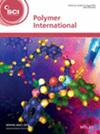Xianqiang Pei, Wenfang He, Zhancheng Zhang, Rongmin Wang, Yaoming Zhang, Qihua Wang, Tingmei Wang
求助PDF
{"title":"MXene–CF synergy to improve tribological properties of epoxy resin/carboxyl-terminated butadiene acrylonitrile","authors":"Xianqiang Pei, Wenfang He, Zhancheng Zhang, Rongmin Wang, Yaoming Zhang, Qihua Wang, Tingmei Wang","doi":"10.1002/pi.6723","DOIUrl":null,"url":null,"abstract":"<p>The use of hybrid fillers provides a new route for improving the friction and wear properties of polymer composites due to their synergistic effect. In the present study, a two-dimensional derivative of MAX phases (MXene) was loaded onto the surface of carbon fiber (<i>CF</i>) and used as reinforcement to modify the tribological properties of epoxy resin (EP) composites. The latter were tested on a plate-on-ring contact configuration as a function of load and sliding speed with reference to composites filled with single carboxyl-terminated butadiene acrylonitrile (CTBN), MXene and <i>CF</i>. It was revealed that, when MXene and <i>CF</i> were incorporated simultaneously into EP/CTBN, the composite's friction coefficient and wear rate were reduced by 55.8% and 96.6% compared to those of EP/CTBN matrix. The mechanisms underlying this improvement are discussed based on a thorough analysis of the morphology of the worn surface and the chemical composition of transfer films. As a result, synergistic interaction between MX@<i>CF</i> and the rubber phase was revealed. © 2024 Society of Chemical Industry.</p>","PeriodicalId":20404,"journal":{"name":"Polymer International","volume":"74 4","pages":"324-335"},"PeriodicalIF":3.6000,"publicationDate":"2024-11-20","publicationTypes":"Journal Article","fieldsOfStudy":null,"isOpenAccess":false,"openAccessPdf":"","citationCount":"0","resultStr":null,"platform":"Semanticscholar","paperid":null,"PeriodicalName":"Polymer International","FirstCategoryId":"92","ListUrlMain":"https://scijournals.onlinelibrary.wiley.com/doi/10.1002/pi.6723","RegionNum":4,"RegionCategory":"化学","ArticlePicture":[],"TitleCN":null,"AbstractTextCN":null,"PMCID":null,"EPubDate":"","PubModel":"","JCR":"Q2","JCRName":"POLYMER SCIENCE","Score":null,"Total":0}
引用次数: 0
引用
批量引用
Abstract
The use of hybrid fillers provides a new route for improving the friction and wear properties of polymer composites due to their synergistic effect. In the present study, a two-dimensional derivative of MAX phases (MXene) was loaded onto the surface of carbon fiber (CF ) and used as reinforcement to modify the tribological properties of epoxy resin (EP) composites. The latter were tested on a plate-on-ring contact configuration as a function of load and sliding speed with reference to composites filled with single carboxyl-terminated butadiene acrylonitrile (CTBN), MXene and CF . It was revealed that, when MXene and CF were incorporated simultaneously into EP/CTBN, the composite's friction coefficient and wear rate were reduced by 55.8% and 96.6% compared to those of EP/CTBN matrix. The mechanisms underlying this improvement are discussed based on a thorough analysis of the morphology of the worn surface and the chemical composition of transfer films. As a result, synergistic interaction between MX@CF and the rubber phase was revealed. © 2024 Society of Chemical Industry.
MXene-CF协同作用改善环氧树脂/端羧基丁二烯丙烯腈的摩擦学性能
由于混合填料的协同效应,使用混合填料为改善聚合物复合材料的摩擦和磨损性能提供了一条新途径。在本研究中,将 MAX 相的二维衍生物(MXene)负载到碳纤维(CF)表面,并将其用作增强材料来改变环氧树脂(EP)复合材料的摩擦学性能。参照填充了单一羧基封端丁二烯丙烯腈(CTBN)、MXene 和 CF 的复合材料,在环板接触配置上测试了后者在载荷和滑动速度作用下的性能。结果表明,在 EP/CTBN 中同时加入 MXene 和 CF 时,复合材料的摩擦系数和磨损率与 EP/CTBN 基体相比分别降低了 55.8% 和 96.6%。在对磨损表面的形态和转移膜的化学成分进行深入分析的基础上,讨论了这种改进的机制。结果表明,MX@CF 与橡胶相之间存在协同作用。© 2024 化学工业协会。
本文章由计算机程序翻译,如有差异,请以英文原文为准。




 求助内容:
求助内容: 应助结果提醒方式:
应助结果提醒方式:


